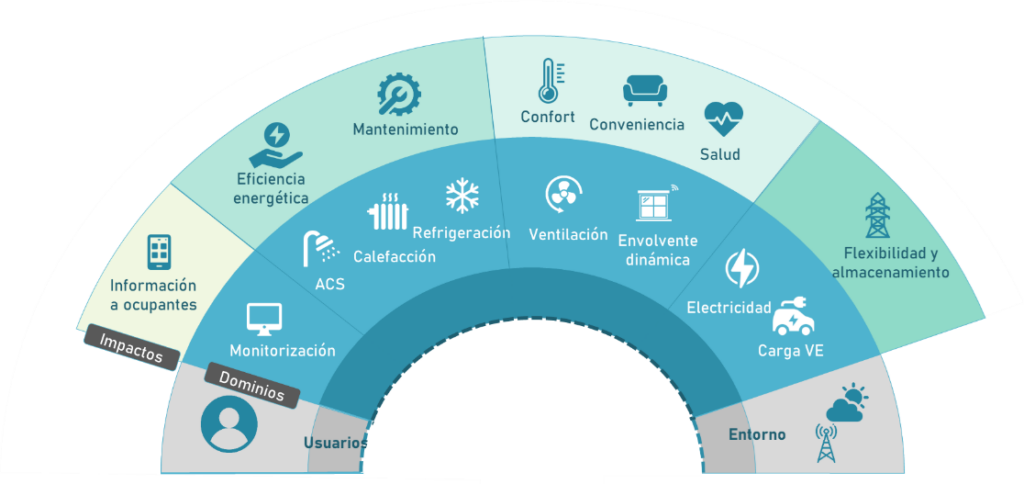Did you know that we spend approximately 90% of our time inside buildings, and that they are responsible for more than 40% of energy consumption in the European Union? These places where we carry out our main activity are the core of our economy and society, but, how prepared are they for the challenges and opportunities of today and tomorrow?

The building sotck plays a key role in transforming the places where we work, live and socialise. The actions promoted by the European Union with the Green Deal or the Renovation Wave have sought to drive this change, Moreover, since the 2018 revision of the European Energy Performance of Buildings Directive (EPBD)1– which, by the way, has just been updated again- the potential of smart technologies takes on a fundamental role. Digitalisation therefore seems to be key to reach the transformation of the places where we live, to enhance and contribute to the energy transition.
This is why in the 2018 revision of the EPBD directive the Smart Readiness Indicator (SRI)2 was also introduced as an optional shceme to measure the level of smart preparedness of buildings. This scheme is born in a first technical study for the European Commision in 2017/18 and is revised in a subsequent iteration on 2019/20, associating a calculation methodology3. It is in 2020 that its implementation is regulated for the first time4, and since 2021 a support team has been in place to assist with its adoption. Given its non-mandatory nature, the decision on its implementation lies with the member countries of the European Union, and for this reason it is currently in the voluntary testing phase in some countries, including Spain.
And what does this indicator allow us to know? The SRI assesses the building in terms of three key functionalities fully aligned with the concept of intelligence: (1) how the building responds to the needs of the occupants, (2) the use of strategies to improve energy efficiency and performance, (3) its ability to interact with the exterior and react to the environment. To this end, a catalogue of servicies classified into nine technical domains, assessed on the basis of seven impacts, is proposed.
Let´s see how it works with an example: you want to improve the performance of the building´s heating system. It may not be possible to realise automatic control, either central or even more advanced, allowing room-by-room control. Based on the level of functionality chosen, the higher the capability offered, the more intelligent the implementation will be assessed as being able to provide more beneficial impacts to users in terms of energy efficiency, comfort, convenience or health. These impacts will in turn score higher than services with lower functionality. The calculation method can be found in the final EC technical report cited above, and there are also supporting materials, examples and digital tools to make the process easier5.

The implementation of smart technologies can help us to achieve buildings that are better in terms of energy, healthier, more comfortable and more environmentally friendly. However, aspects such as the lack of knowledge and awareness, the need for accurate information to contextualise these recommendations, or the lack of user confidence in the benefits that smart solutions can bring, make their adoption less straightforward. There are numerous projects that aim to support the uptake activities of such an initiative, such as SMARTeeSTORY or BuildON, in which CARTIF is involved, where we will try to go a step further and offer support to end users on what measures to adopt for the smart transformation of the building and its improvement inthe desire domain/impact. We hope that in this way we can help to ensure that, in a not so distant future, the buildings in which our time moves forward will become the place where we would like to live.
1 https://eur-lex.europa.eu/legal-content/EN/TXT/?uri=uriserv:OJ.L_.2018.156.01.0075.01.ENG
2 https://energy.ec.europa.eu/topics/energy-efficiency/energy-efficient-buildings/smart-readiness-indicator_en
3 European Commission, Directorate-General for Energy, Verbeke, S., Aerts, D., Reynders, G. et al., Final report on the technical support to the development of a smart readiness indicator for buildings – Final report, Publications Office, 2020, https://data.europa.eu/doi/10.2833/41100
4 https://eur-lex.europa.eu/legal-content/EN/TXT/?uri=uriserv:OJ.L_.2020.431.01.0009.01.ENG
5 https://energy.ec.europa.eu/topics/energy-efficiency/energy-efficient-buildings/smart-readiness-indicator/sri-implementation-tools_en?prefLang=es&etrans=es#sri-digital-calculation-tools
- Today´s buildings, ready for tomorrow? - 23 February 2024
